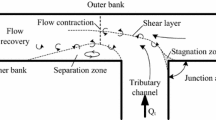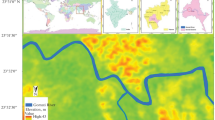Abstract
Models of flow at river-channel confluences that consist of two concordant confluent channels with avalanche faces dipping into a scour zone are limited because this morphology may be the exception rather than the rule in nature. In this paper the mean and turbulent flow structure in the streamwise and vertical directions at both concordant and discordant laboratory confluences were examined in order to determine the effect of bed discordance on the flow field, and to assess its influence on sediment transport. Instantaneous velocities were measured with a laser Doppler anemometer using a dense spatial sampling grid. The spatial distribution of normal stress varies with bed geometry as bed discordance generates a distortion of the mixing layer between the confluent streams. Turbulent shear stress is larger in the discordant bed case and its peak is associated with the position of the mixing layer whereas for concordant beds the zone of mixing is characterised by a decrease in the Reynolds shear stress. Quadrant analysis also revealed differential dominating quadrants between the two bed geometries which will influence sediment transport routing and, consequently, the resulting bed morphology. These results highlight the need for significant modifications to current models of confluence flow dynamics in order to account for the bed configuration.
Similar content being viewed by others
References
Ashmore PE; Ferguson RI; Prestegaard KL; Ashworth PJ; Paola C (1992) Secondary flow in anabranch confluences of a braided, gravel-bed stream. Earth Surf Processes Landforms 17: 299–311
Bennett SJ; Best JL (1995) Mean flow and turbulence structure over fixed, two-dimensional dunes: implications for sediment transport and bedform stability. Sedimentology 42: 491–513
Best JL (1986) The morphology of river channel confluences. Progress Phys Geography 10: 157–174
Best JL (1988) Sediment transport and bed morphology at river channel confluences. Sedimentology 35: 481–498
Best JL (1987) Flow dynamics at river channel confluences: implications for sediment transport and bed morphology. In: Recent developments in fluvial sedimentology, eds. F.G. Ethridge; R.M. Flores; M.D. Harvey, SEPM Special Publication 39: 27–35
Best JL (1993) On the interactions between turbulent flow structure, sediment transport and bedform development: some considerations from recent experimental research. In: Turbulence: perspectives on flow and sediment transport, eds. N.J. Clifford; J.R. French; J. Hardisty. Chichester: Wiley: 61–92
Best JL; Roy AG (1991) Mixing-layer distortion at the confluence of channels of different depth. Nature 350: 411–413
Biron P; Best JL; Roy AG The fluid dynamics effects of bed height discordance at open channel confluences. J Hydraulic Eng ASCE (in press)
Biron P; De Serres B; Roy AG; Best JL (1993a) Shear layer turbulence at an unequal depth channel confluence. In: Turbulence: perspectives on flow and sediment transport, eds. N.J. Clifford; J.R. French; J. Hardisty. Chichester: Wiley: 197–214
Biron P; Roy AG; Best JL; Boyer CJ (1993b) Bed morphology and sedimentology at the confluence of unequal depth channels. Geomorphology 8: 115–129
Biron P; Roy AG; Best JL (1995) A scheme for resampling, filtering and subsampling laser Doppler anemometer data. Math Geol 27: 731–748
Browand FK; Troutt TR (1985) The turbulent mixing layer: geometry of large vortices. J Fluid Mech 158: 489–509
Chu VH; Babarutsi S (1988) Confinement and bed-friction effects in shallow turbulent mixing layers. Proc Am Soc Civil Eng. J Hydr Eng 114: 1257–1274
Gaudet JM; Roy AG (1995) Effect of bed morphology on flow mixing length at river confluences. Nature 373: 138–139
Heathershaw AD (1979) The turbulent structure of the bottom boundary layer in a tidal current. Geophys J Roy Astronom Soc 58: 395–430
Kaimal JC; Haugen DA (1969) Some errors in the measurement of Reynolds Stress. J Appl Meteor 8: 460–462
Kennedy BA (1984) On Playfair's law of accordant junctions. Earth Surf Processes Landforms 9: 291–307
Leeder MR (1983) On the interactions between turbulent flow, sediment transport and bedform mechanics in channelized flows. Special Publications of the International Association of Sedimentologists 6: 5–18
Lu SS; Willmarth WW (1973) Measurements of the structure of the Reynolds stress in a turbulent boundary layer. J Fluid Mech 60: 481–511
McLean SR; Nelson JM; Wolfe SR (1994) Turbulence structure over two-dimensional bedforms: implications for sediment transport. J Geophys Res 99: 12729–12747
McLelland SJ; Ashworth PJ; Best JL (1996) The origin and development of coherent flow structures at channel junctions. In: Coherent flow structures in open channels, eds P.J. Ashworth; S.J. Bennett; J.L. Best; S.J. McLelland. Chichester: Wiley: 459–490
Modi PN; Ariel PD; Dandekar MM (1981) Conformal mapping for channel junction flow. Proc Am Soc Civil Eng. J Hyd Eng 107: 1713–1733
Mosley MP (1976) An experimental study of channel confluences. J Geo 84: 535–562
Ramamurthy AS; Carballada IB; Minh Tran D (1988) Combining open channel flow at right angled junctions. Proc Am Soc Civil Eng. J Hyd Eng 114: 1449–1460
Rhoads BL (1996) Mean structure of transport-effective flows at an asymmetrical confluence when the main stream is dominant. In: Coherent flow structures in open channels, eds. P.J. Ashworth; S.J. Bennett; J.L. Best; S.J. McLelland. Chichester: Wiley: 491–517
Rhoads BL; Kenworthy ST (1995) Field measurements of flow structure at a high-angle asymmetrical stream confluence. Geomorphology 11: 273–293
Roy AG; Bergeron N (1990) Flow and particle paths at a natural river confluence with coarse bed material. Geomorphology 3: 99–112
Roy AG; Biron P; De Serres B On the necessity of applying a correction to instantaneous velocity measurements in river flows. Earth Surf Processes Landforms (in press)
Roy AG; De Serres B (1989) Morphologie du lit et dynamique des confluents de cours d'eau. Bull Soc Géographique Liège 25: 113–127
Roy AG; Roy R; Bergeron N (1988) Hydraulic geometry and changes in flow velocity at a river confluence with coarse bed material. Earth Surf Processes Landforms 13: 583–598
Sternberg HO (1975) The Amazon River of Brazil 74. Steiner: Weisbader
Townsend AA (1976) The structure of turbulent shear flow. Cambridge: Cambridge Univ. Press, 2nd Edition
Weerakoon SB; Kawahara Y; Tamai N (1991) Three-dimensional flow structure in channel confluences of rectangular section. Proc XXIV Congress. Int Assoc Hyd Res A373–380
Williams JJ; Thoren PD; Heathershaw AD (1989) Measurements of turbulence in the benthic boundary layer over a gravel bed. Sedimentology 36: 959–971
Willmarth WW; Lu SS (1972) Structure of the Reynolds stress near the wall. J Fluid Mech 55: 65–92
Author information
Authors and Affiliations
Additional information
We would like to thank Phil Fields of the Earth Sciences workshop at Leeds for his skillful construction of the confluence model and continued help during the course of this research. The LDA facility has been funded through grants from the UFC, NERC and University of Leeds. PB thanks NSERC for financial support and the Fonds FCAR for funding an eight month study-visit held at the Department of Earth Sciences, University of Leeds. AGR acknowledges the financial support of NSERC whilst JLB is grateful for the award of a Nuffield Science Foundation Fellowship which facilitated the preparation of this paper. We thank two anonymous reviewers for their constructive criticisms that helped clarifying the paper.
Rights and permissions
About this article
Cite this article
Biron, P., Roy, A.G. & Best, J.L. Turbulent flow structure at concordant and discordant open-channel confluences. Experiments in Fluids 21, 437–446 (1996). https://doi.org/10.1007/BF00189046
Received:
Accepted:
Issue Date:
DOI: https://doi.org/10.1007/BF00189046




